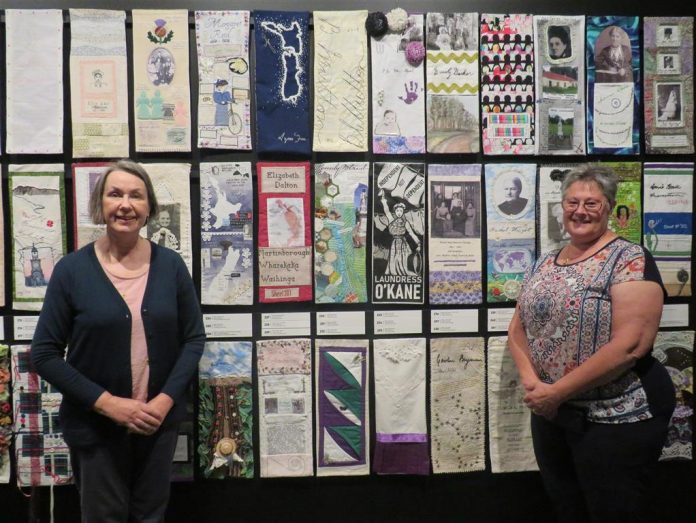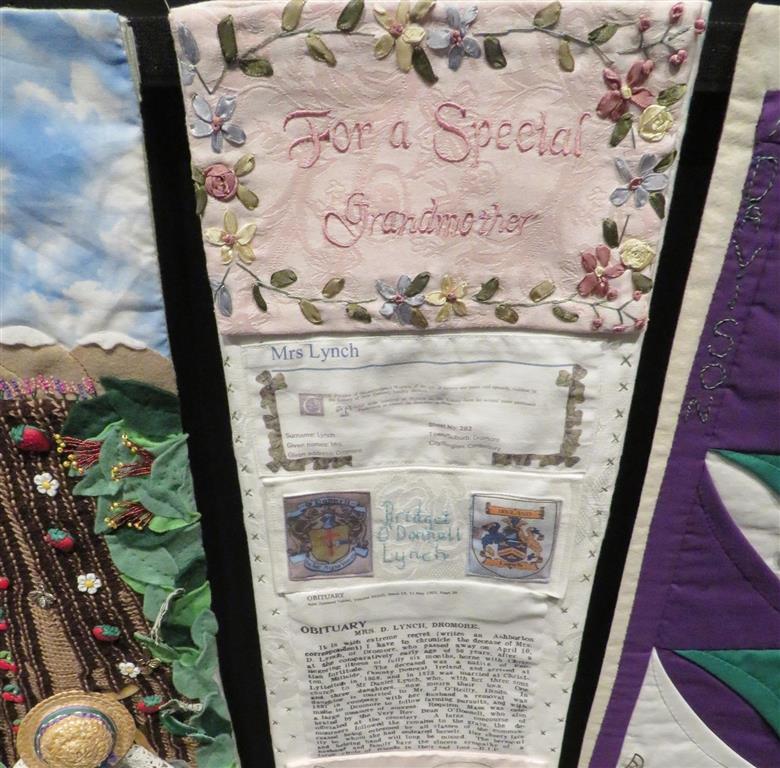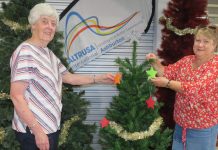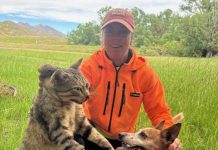
Beautifully handmade panels adorning the walls of both the Ashburton Museum and Ashburton Art Gallery tell the story of 546 ordinary women who helped change New Zealand.
Those women were suffragists, a fighting force for fairness, demanding the right to vote.
The panels feature in the nationwide touring Suffrage in Stitches exhibition, which is at the gallery to February 18.
The gallery is the only South Island site to have hosted the exhibition, which acknowledges some of the 31,872 people who signed the 1893 Women’s Suffrage Petition.
The works were originally created some years ago, to mark the 125th anniversary of women’s suffrage in 2018.
The exhibition was developed by Wellington Museum in partnership with charitable group Vinnies Re Sew, to honour the whakapapa, history and power of New Zealanders.
Just as it was ordinary women from all social spectrums who signed the petition, the creators of each of the panels were individuals, families and groups who, regardless of their education, background or experience got involved to pay tribute to the suffragists who had been part of such an important movement.
It started as a collective exhibition, and has emerged as a sharing of history, connection of people and feeling of togetherness.
The 300m length of the work represents the length of the original petition, while the 546 panels represent the number of pages in the petition.
The driving force behind the suffragist movement was Kate Sheppard, supported nationwide by members of the Women’s Christian Temperance Movement.
The stories of the women depicted in the panels can be found online at www.suffrageinstitches.nz/
Some of the panels tell the stories of suffragists from Mid Canterbury. They include Eliza Ellen Kersel, Elisa Millichamp, Agnes Davison, Emily Bland, Bridget Lynch, B Mutton and Mary Claridge.
Another Mid Canterbury connection is through Anne Whitehead of Ashburton, who made one of the panels, telling the story of Elizabeth Bickerstaff.
Some are detailed below.
– Eliza Ellen Kersel, panel 233, was made by her daughter’s great-grandmother Tracy Kersel. According to her sons’ military records, Eliza Guest was born in Brighton, England.
She married John Kersel from Scotland in 1888, in New Zealand and they lived in Allenton for several years. By 1911 they had moved to Palmerston North.
She had at least eight children, six boys, one dying in infancy and two girls. Two of her sons saw active service in France in World War I and a third also joined the army. All four sons survived the war.
– Eliza Millichamp, panel 226. Members of five generations made this panel – Zoe Tull, Sally Pascall, Jane Flippence, Alice Spinner, Gemma Pascall, Lilly Flippence.
Eliza Emma Thorp was born in Yorkshire, England in September 1856, the third daughter of Mary Burton and Thomas Thorp. Her father was a carpenter.
When she was 17 the family migrated to New Zealand on the Carisbrooke Castle.
They arrived at Lyttelton in September 1874. Eliza’s seven siblings – three sisters and four brothers – also travelled to Canterbury.
She married John Millichamp in 1877 in Temuka. They moved to Ashburton in 1880 and set up Millichamp’s Nursery in 1886. They grew strawberries, cherries, and rhubarb for sale at first but soon planted trees between the rows.
Tinwald was the family home when she signed the 1893 suffrage petition and enrolled to vote in the following elections. She had also signed the 1892 petition.
After John died in 1912, she married a man 14 years her junior, labourer James Reilly, in 1913.
Eliza’s sister Ann White also signed the suffrage petition.
– Agnes Davison, panel 232, was made by Carole Taylor. Agnes was born in Ireland in 1845 during the potato famine, and was baptised in Ballymena, Ireland. Her parents were Agnes Gavin and Joseph Houston.
On February 6, 1866, she married William Davison in Ahoghill and over the next eight years had four children.
In August 1874, the family left Ireland for Australia, sailing on the St Vincent from Plymouth, England.
They arrived in Adelaide in November 1874 and bought land near Burra Burra, South Australia.
Five more children were born: William, Annie, Olive, Agnes, and Priscilla, but by 1888, after four years of devastating drought, the Davisons left for New Zealand.
They bought a farm on Winslow-Willowby Rd in the Ashburton District. Their 10th child was born the following year.
Agnes signed the petition when living at Willowby and enrolled to vote from there in 1893 and 1896, as did Margaret Davidson [domestic servant].
– Emily Bland, panel 231, was made by Jan Connett. Emily Watson arrived fresh off the boat from England in 1877.
At 19, she had been ‘sent for’ to join her parents and the eldest of her nine siblings: pioneers, carving out farms from the swamps, bush, and endless, tussocky Canterbury plains.
It was relentless hard work, punctuated by frequent tragic accidents.
Emily married farmer William Bland in 1884, but he was dead within 18 months, killed by his own loaded gun as he lifted it down from the rafters in the barn.
She faced raising Dora, their tiny daughter, and running the successful sheep station on her own.
She engaged a station manager and occasionally employed William’s brothers and nephews as farm hands.
Electoral rolls and other documents show her as a farmer over the following years, variously listed in Greenstreet, Winchmore, Methven and Ashburton.
– Bridget Lynch, panel 229. Pauline Leverton, created the panel to honour her great grandmother Bridget Lynch.
Bridget O’Donnell was from Fenton in County Donegal, Ireland.
She arrived in Lyttelton in 1868 and married Daniel Lynch at Christchurch in 1873. The couple had three sons and three daughters.
They began farming pursuits in Dromore, near Ashburton, in 1887 with a large measure of success.
– B Mutton, panel 230, was made by Billee Mutton. The Mutton family arrived very early on in Canterbury’s colonial history. B. Mutton signed the 1893 petition in Ashburton.
– Mary Claridge, panel 237. Many of the makers of panels are members of the suffragists family, as is the case here. The panel on Mary Claridge which was made by Lynne Prattley; her husband is the great grandson of Mary.

Rhoda was known as Mary. She was born in London February 1861 to Jane Elizabeth Cave and Thomas Adkisson Gates.
The family emigrated to New Zealand on the Indian Empire, arriving at Lyttelton in March 1864.
She married farmer Arthur Charles Claridge at St Stephens Church, Ashburton in December 1884. They had six children – the eldest a boy, Arthur, followed by five girls: Beatrice, Ethel, Catherine Ruby, Gertrude, and Jane.
She was living in Ashburton when she signed the 1893 petition. In the 1893 and 1896 electoral rolls she was listed as a music teacher. Mary died in October 1922 and was buried in Ashburton cemetery.
– Elizabeth Bickerstaff, panel 213 was made by Ashburton woman Anne Whitehead.
Elizabeth was her great, great grand mother. Mrs Bickerstaff (known as Lizzie) was born Mary Elizabeth Freeman on January 16, 1856 in Bootle, England. She married Robert Bickerstaff on Christmas Day, 1875 at St Mary’s Church, Edge Hill, England.
They had five children before they came to New Zealand on the SS Westland, which departed from Plymouth August 11, 1883 and arrived in Wellington October 31, 1883. They then travelled to Napier where they joined Robert’s father George Herbert. George had paid the family’s passage.
Lizzie had a further six children. Sadly, she died on 20 January 1907 at the age of 51 – in a diabetic coma.
■ Suffrage in Stitches exhibition on at the Ashburton Museum and Ashburton Art Gallery, West St, to February 18. Open daily 10am to 4pm.



